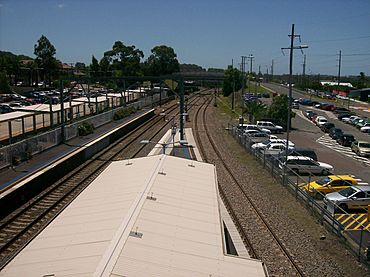Wyong, New South Wales facts for kids
Quick facts for kids WyongCentral Coast, New South Wales |
|||||||||||||||
|---|---|---|---|---|---|---|---|---|---|---|---|---|---|---|---|

Wyong railway station
|
|||||||||||||||
| Population | 4,530 (2021 census) | ||||||||||||||
| • Density | 503/km2 (1,300/sq mi) | ||||||||||||||
| Postcode(s) | 2259 | ||||||||||||||
| Elevation | 22 m (72 ft) | ||||||||||||||
| Area | 9 km2 (3.5 sq mi) | ||||||||||||||
| Location |
|
||||||||||||||
| LGA(s) | Central Coast Council | ||||||||||||||
| Parish | Munmorah | ||||||||||||||
| State electorate(s) | Wyong | ||||||||||||||
| Federal Division(s) | Dobell | ||||||||||||||
|
|||||||||||||||
Wyong is a town on the Central Coast of New South Wales, Australia. It is about 63 kilometers (39 miles) south-southwest of Newcastle. It is also about 93 kilometers (58 miles) north-northeast of Sydney, the state capital.
Wyong was started in 1888. It is one of two main centers for the Central Coast Council. This council manages the local area.
Contents
Discovering Wyong's Past
The name Wyong comes from an Indigenous word. It means either 'an edible yam' or 'place of running water'.
William Cape was the first European person to settle here. He arrived in 1825. He brought cattle and sheep to the area. He settled on a large piece of land near Jilliby Creek. His two sons also received land grants.
Historic Buildings and Places
Wyong has several old and important buildings. They tell us about the town's history:
- Alison Homestead, on Cape Road, was built around 1885. Sadly, it was destroyed by fire in 2011.
- Chapmans Store opened in 1901. You can find it at the corner of Alison Road and Hely Street.
- The Court House on Alison Road was built in 1924. This spot was once where the first Post Office stood in 1892.
- St Cecilia's Church on Byron Street was built in 1908. It is the oldest church in Wyong and is still used today.
- Strathavon, on Boyce Avenue, was built between 1912 and 1913. It used to be called Hakone.
- The Turreted buildings were built in 1915 by Albert Hamlyn Warner. They are at the corner of Church Street.
- Wyong Public School on Alison Road was built in 1889. It stopped being a school in September 1979.
- Wyong Milk Factory, at 141 Alison Road, was built around 1921.
Workers' Stand at Wyong Plaza
In May 1974, something important happened at the Wyong Plaza shopping center. Construction workers were building it. When one worker was fired, 67 workers decided to take action.
They announced they would stay on the job until all workers could return. For six weeks, they worked together to make decisions about the job. They stopped only when the company agreed to better pay and conditions. This included workers having a say in hiring and firing.
Who Lives in Wyong?
The 2021 census counted 4,530 people living in Wyong.
- About 6.3% of the people were Aboriginal and Torres Strait Islander people.
- Most people, 73.8%, were born in Australia.
- The next largest group, 3.3%, were born in England.
- About 81.2% of people spoke only English at home.
- For religion, 36.6% said they had no religion. Catholic was 19.2%, and Anglican was 17.2%.
The wider Wyong area, which includes the northeast Central Coast, had a population of 168,171 people.
Town Facilities and Services
Wyong has a busy and well-organized town center. It has one of the two main Central Coast Council Chambers. You can also find the Village Central Wyong Shopping Centre here.
Other important places include:
- The Hunter and Central Coast Institute of TAFE Wyong Campus.
- Wyong Police Station.
- Wyong Local Court House.
- The Art House Wyong Performing Arts and Conference Centre.
- Banks, government offices, local businesses, and community services.
Wyong Public School is north of the town center on Cutler Drive. Wyong High School is west of the town center on Alison Road.
Wyong Racecourse is a key place for horse racing. It holds races every week. The town also has many sports and fun places.
Wyong Hospital is not in the town itself. It is about 8.6 kilometers (5.3 miles) northeast in Hamlyn Terrace.
Getting Around Wyong
Wyong is a central point for transport in the northern Central Coast region.
Wyong railway station offers train services by NSW TrainLink. Bus services are run by Busways, Coastal Liner, and Red Bus Services. The Pacific Highway used to go through the town. However, a bypass was built in December 1983.
Famous People from Wyong
Some well-known people have lived in or come from Wyong:
- Dale Buggins, a motorcycle stunt rider.
- Steve Carter, a rugby league player.
- Roy Ferguson, another rugby league player.
- Noel Miller, a cricketer.
- Mark Skaife, a race car driver.


